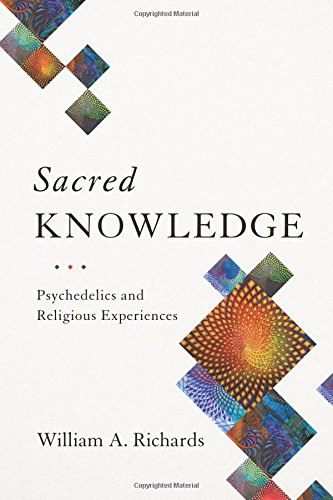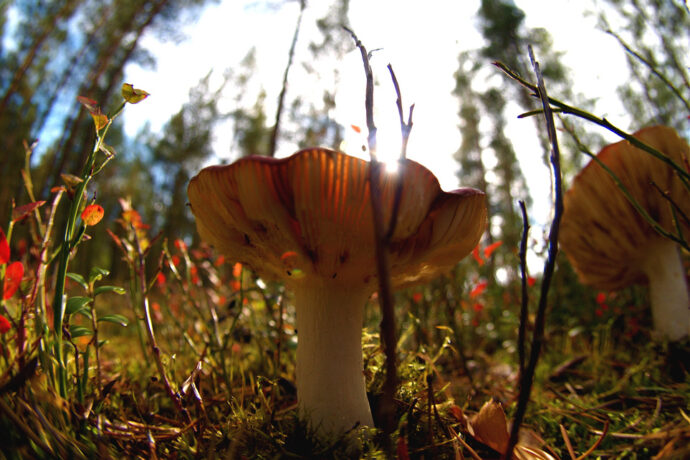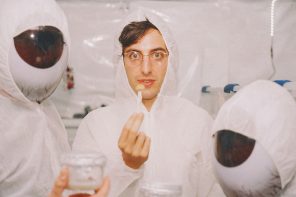“Turn on, tune in, drop out.” Timothy Leary’s famous exhortation still influences our view of so-called psychedelic or hallucinogenic substances. We might associate psychedelics with the excesses of sixties counterculture, and with “straight” society’s pushback, replete with fear-mongering and willful misunderstanding.

Sacred Knowledge: Psychedelics and Religious Experiences
William A. Richards
Columbia University Press
December 8, 2015
Richards has spent the bulk of his career researching such substances—which, in line with an established literature, he prefers to call “entheogens”—and their therapeutic uses. Sacred Knowledge: Psychedelics and Religious Experience is not only a summation of his work—one that effortlessly mixes the results of scientific research, case studies, anecdotes, and interpretative commentary—but an apologia for the use of entheogens in controlled settings.
It’s an impassioned, though quite reasonable, plea for us to start viewing these sometimes-strange substances as medicine for the soul.
Richards is, of course, not alone. Research into the medical and psychological use and value of psychedelics all but halted in the 1970s. There are many reasons for this, but inclusion of many psychedelics in the Controlled Substances Act of 1970 under Schedule 1 certainly didn’t help. Nevertheless, research has been on the uptick since the late 1990s, with numerous respected institutions running successful, peer-reviewed clinical trials. Such research remains outside the mainstream, but it has in recent years received a fair amount of coverage in popular media.
“…it’s [that] characteristic—i.e., the potential of psychedelics to open the mind to a so-called religious or mystical dimension of human existence—that makes them such effective medicine.”
It is hard not to be convinced by the case Richards makes. Consistent with other studies, he discusses the benefits of entheogenic treatment for a host of ailments, including addiction, depression, anxiety, chronic pain, and psychosomatic symptoms associated with illness and trauma. The benefits, moreover, aren’t just physical (in the sense that taking a few ibuprofen reliably relieves aches and pains) but psychological and, moreover, religious.
Indeed, on Richards’s account, it is the potential of psychedelics to open the mind to a so-called religious or mystical dimension of human existence that makes them such effective medicine.
Richards tends to read entheogenic experiences through the lens of an archetypal, sui generis understanding of religion, one that’s heavily influenced by philosophical and theological existentialism. In other words, religion, for Richards, is unique, irreducible, and universal, an elemental feature of human existence in general.
He is largely dismissive of attempts to understand religious experience and traditions in terms of linguistic, social, and cultural forms and, because of this, tends to collapse the study of religion into theology. This conflation persists throughout the book, but is most clearly stated when he discusses the “Psychedelic Frontiers in Religion,” that is, how entheogens may lead us “to better understand the ‘mind of God’ and the mysteries of our own being.” Indeed, the very use of the term “entheogen,” which literally means “generating God within,” shores up this bias toward the unicity of religious experience.
Such a view leads Richards to collapse the distinctions between religious traditions, as a means of comparing the effects of entheogens with “the sacred.” With a nod to Aldous Huxley, he favors, as he states early on in the book, a “perennialist view” of religious experience, since this is where the “evidence” leads him. Statements such as the following, made in the context of discussing how psychedelic substances may produce an experience of “mystical consciousness,” thus populate his account:
“All of the great world religions have words that point toward this highly desired and valued state of spiritual awareness, such as samadhi in Hinduism, nirvana in Buddhism, sekhel mufla in Judaism, the beatific vision in Christianity, baqá wa faná in Islam, and wu wei in Taoism.”
As Richards relates, his first personal experience with psychedelics, which he recounts in the Preface, occurred while he was a graduate student in theology and psychiatry at the University of Göttigen in the 1960s. Viewing his own mind as a “psychological laboratory,” he volunteered to participate in a research study on the effects of psilocybin, the active ingredient in many psychoactive mushrooms. Upon receiving his first dose, he had an experience of losing his “usual identity” in “the eternal brilliance of mystical consciousness.” It’s important to point out, however, that that experience didn’t come out of nowhere. By his own admission, he went into it primed, so to speak. “Drawing on the piety of my Methodist childhood,” he says, “I silently affirmed trust that God would be with me should any difficult childhood memories emerge.”
It’s important to point out, however, that that experience didn’t come out of nowhere. By his own admission, he went into it primed, so to speak. “Drawing on the piety of my Methodist childhood,” he says, “I silently affirmed trust that God would be with me should any difficult childhood memories emerge.”
A lingering question that I have, then, is the extent to which Richards’ understanding of the value of psychedelics, including what they do and how they work, remains indebted to a particular understanding of religion. I don’t think he would balk at such a question. Although Richards is aware that such experiences can be interpreted differently, he’s upfront that his understanding of, and the categories he uses to describe them, comes down to a “personal choice” to believe “in the validity of mystical consciousness.”
In saying this, my point is not necessarily to cast doubt on Richards’ work. I’m largely convinced of the therapeutic value of psychedelics, and I agree with Richards that scholars of religion (and many a theologian) often exercise too much skepticism when it comes to their “object” of study and, in the process, fail to see the proverbial forest for the trees. One of the things that Richards accomplishes, then, is to remind us of the importance of being open to unexpected experiences, even—or perhaps especially—when they’re piqued by psychedelics or any number of other strange materials.
Nevertheless, his understanding of religion has significant limitations, not only in what it assumes about “religion” but also in what it ignores, or can’t account for.
Throughout Sacred Knowledge, for instance, Richards tends to downplay negative experiences with psychedelics. To put it in terms of his own framework, he tends to cover over what Rudolf Otto called the mysterium tremendum, conceiving the reality to which entheogens provide access ultimately as fascinans, that is, merciful and gracious.
Indeed, the conditions under which researchers and health professionals administer psychedelics within a clinical setting support this elision: great care is taken to assure a positive experience. This elision, moreover, fits with his tendency to equate authentic experiences of “mystical consciousness” with the production of beneficial psychological and moral results. Within Richards’ framework, the states of consciousness that psychedelics provide access to should prompt a sort of conversion in the individual.
At numerous points he conceives of the benefits of the “wise” use of psychedelics in the very Christian terms of sin and salvation.
“…there are no pure religious practices or primal states of consciousness as such, what Richards refers to as the mystical.”
Such limitations might make for good medicine, of course, but determining which comes first is like deciding on either the chicken or the egg: it’s better to view the framework and the substances involved as mutually reinforcing.
That said, although I do have problems with the way in which Richards articulates the putative religious dimensions of psychedelic experiences, I still think it’s possible to take the latter seriously, while adopting a different framework.
Consider, for a moment, a normal session with psilocybin in a contemporary research setting. The participant, who has been vetted in advance according to strict protocols, receives a dose of synthetic psilocybin via injection. The participant then undergoes his or her experience in a clinical yet comfortable environment. The participant reclines on a couch, usually wears an eye mask, and listens to a pre-selected musical soundtrack for the duration of the experience. This sort of sensory control is an important component. Richards says, “Research with entheogens tends to be conducted in interior spaces, where one’s body can safely sink into a couch and the mind can be freed from having to ‘watch over the body.’”
That’s quite different from a traditional Mazatec mushroom ceremony, though. Although the upshot of both may, on the surface, appear similar, that’s not the case if one digs deeper.
For instance, Maria Sabina, the Mazatec curandera who became something of a celebrity in the 1960s among those seeking chemically-induced enlightenment, is reported to have denied the entheogenic aspects of psilocybin, or at the very least understood them as secondary. As Andy Letcher puts it in his Shroom: A Cultural History of the Magic Mushroom, “To find God, Sabina—like all good Catholics—went to Mass.”
Moreover, it’s not even clear that the same substance is being used. While contemporary researchers use synthetic psilocybin, for someone like Sabina, the mushroom itself is essential, and cannot be separated from its chemical makeup. She referred to the mushrooms as “the saint children.”
My point is not to say that Richards and other researchers use such substances inauthentically, as if they’re merely appropriating for their own purposes an otherwise pure, traditional practice. It’s rather to say that there are no pure religious practices or primal states of consciousness as such (what Richards refers to as “the mystical”).
Richards’s use of psychedelic substances in a clinical setting certainly provides access to something, but that “something” isn’t necessarily the same thing wherever such compounds are used. That Richards sees them in religious terms proves the point, if we take seriously Sabina’s statements.
The states of consciousness reached through the use of psychedelics, then, don’t necessarily pre-exist the experience but are, rather, produced in it. Psychedelics, in this sense, aren’t so much revelatory as they are component parts of an assemblage: what they mean and do varies depending on the other technologies, objects, and practices that they’re put in relation to.
Again, that doesn’t obviate the very real effects of psychedelic substances in medical settings. It’s just to take seriously the specificity of that setting: the clinic isn’t a remote village in Mexico. Doing so, I suggest, would complicate our understanding of psychedelics and the way that they interact with different environments.
In addition, it would also complicate our understanding of religion. Scholars of religion have for some time questioned many of the assumptions undergirding the notion of “religion,” showing how it, like most everything else, is a complex product of various cultural, social, political, psychological, and economic negotiations. The translation of the effects of psychedelic substances into medical, psychological, and religious terms, as we see in Sacred Knowledge, shows the production of religion in action. And Richards shows it to us in the most unlikely of places—the research clinic.





